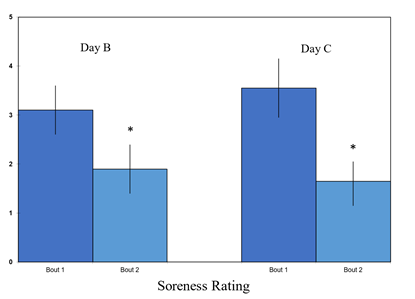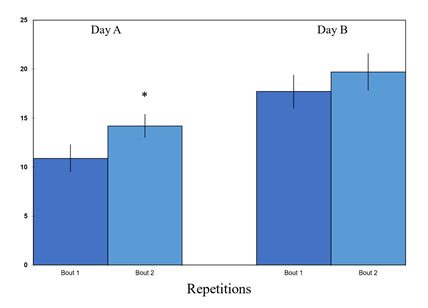Leg Contralateral Repeated Bout Effect for Moderate Exercise Stress
- 1. Ohio State University, USA
Abstract
Introduction: In previous work, moderate leg exercise stress 4 weeks apart did not produce contralateral repeated bout injury protection (exercise induced acute injury in one limb protecting against later induced injury in the other limb).
Aim: A new study used the same stress protocol, but tested for whether protection could occur with a shorter lag time (10 days).
Results: In 31 young adult fitness trained males, moderate injury was produced by a leg extension exercise protocol in one leg and then 10 days later in the other leg. Partial protection was seen based on perceived soreness at 1 and 2 days later (p = 0.02/0.01, paired t test for bout 1 vs bout 2). In addition, protection was seen for leg extension performance at the end of the leg stress (p = 0.01, paired t test for bout 1 vs 2). Creatine kinase assessments were too inconsistent to be useful.
Conclusion: Protection transfer between limbs may depend on the stress intensity, the type of protocol and measures used, and time between stress exposures.
Keywords: Contralateral Protection; Repeated Bout; Soreness; Stress; Leg Extensions
Introduction
Repeated bout protection against exercise stress injury in one body area is well established, but partial protection can also transfer between limbs (contralateral protection) [1]. Hody et al. [2], found such protection in legs even with 6 weeks between stress sessions and regardless of which leg was stressed first.
In contrast, our group found that in trained subjects, a nutritional intervention + leg change gave partial protection, but leg change alone did not [3]. The lag between tests was 4 weeks, which is less than the 6 weeks of Hody et al [2]. However, our study had less initial injury than Hody et al. Our study also had less injury than some other studies showing contralateral protection, including studies in untrained subjects with high vulnerability to muscle or joint stress [4].
In other studies [5], as with our study [3], substantial contralateral protection did not occur. Contralateral protection may depend on the exercise stress intensity and nature, the time between stresses, and measures taken. Our previous negative result may be fairly unique because a moderate stress was employed in both sessions with a substantial lag in between. This moderate stress might give protection with a shorter lag, a possibility tested with a new study.
Materials and Methods
Subjects were 18-25 years old non smoking males who had done weight training including legwork > twice a week for > 30 minutes for > 12 months (n =31). Subjects lacked major inflammatory problems and leg injuries. Eligibility was determined by questionnaire. The protocol was approved by the Ohio State University Human Subject Biomedical Institutional Review Board. Exercise stress was one leg exercises on a Paramount leg extension machine, Model SP-5000. Before the first stress session, a pre-session determined positionings and weight amounts. The stress session used eight sets (1 minute rest between sets):
•Sets 1/2: 12 repetitions
•Sets 3/4: 10 repetitions with 1 second pause at top (5 lbs < Sets 1 and 2)
•Sets 5/6: 10 repetitions eccentric* (weight from Set 1)
•Set 7: 10 repetitions eccentric (5 lbs < Set 1)
•Set 8: Maximal repetitions (Set 1 weight)
•Set 9: 24 h after Set 8 (same procedure as Set 8)
*Subjects were aided on the upward lift and lowered the weight to a 5 count
Leg extensions were performed with the dominant leg at baseline and non-dominant leg for contralateral protection testing. Repetitions were constant for pre- and post-test except for Sets 8 and 9 (maximal repetitions). The sequence was:
Day A: 8-Set exercise stress → 24h recovery
Day B: Soreness scale + leg extensions (set 9) → 24h recovery
Day C: Soreness scale
The soreness scale was:
• 0 No soreness
•1 No soreness if standing or walking, but can feel a twinge with a squat
•2 No soreness if standing or walking, but can feel a little sore with a squat
•3 Can feel a little soreness if walking but not standing
•4 Can easily feel some soreness if walking
•5 Can feel moderate soreness if walking
•6 Can feel a lot of soreness if walking
•7 Can’t hardly move without a lot of soreness
•8 Very sore with any movement
• 9 Hurts so bad that I need to take a pain reliever
•10 Actually have an injury that does not allow normal movement
Blood was taken just after the stress session and 24 hours later for plasma creatine kinase activity assay on a Cobas C111 analyzer.
Statistical significance was set at p < 0.05. Calculations used Microsoft Excel. For each measure, bout 2 results were compared to bout 1 results by paired t-test.
Results and Discussion
The first exercise stress gave moderate injury based on soreness perception (Figure 1). Mean values for the second exercise stress were reduced at 2 time points post-stress vs bout one. Maximal leg extension repetitions at bout’s end were also used to assess injury by immediate muscle strength limitation. Some limitation occurred since repetitions were under what could be done 24 hours later (Figure 2). Mean maximal repetitions at bout’s end improved for bout 2 vs 1 (Figure 2). Mean improvement also occurred for the next day’s set, but didn’t reach statistical significance.
Plasma creatine kinase activities, a muscle damage marker, followed no consistent pattern. Even the expected rises after the first exercise stress didn’t always occur. Valus for this measure can vary among individuals after exercise stress. For example, in Xin et al. [6], despite a statistically significant post-exercise stress rise, high intersubject variations occurred.
Based on the data from the two figures, moderate exercise stress gave partial contralateral protection against the same stress. The effect was seen at 10 days, but was not seen previously with the same exercise stress + a 4 week lag [3]. Previous contralateral protection demonstrations have generally used more strenuous localized stress [2,4]. For such stress, protection can be seen despite substantial lags before the second stress. In contrast, short lags seem needed for most measures of mild initial exercise stress contralateral protection (ie < 1 week). Thus, exercise stress severity, timing between stress sessions, and measures used interact to determine whether contralateral protection occurs. The protection seen here was based partly on maximal repetitions at stress session end. This could just reflect psychological adaptation. However, this same protocol didn’t produce such adaptation previously with a longer lag between stress sessions [3].
Figure 1

Figure 1: Soreness scale evaluations at 1 and 2 days after exercise stress session (Day B and Day C, respectively). Subjects (N=31) did a subjective soreness rating based on the descriptions noted in the Methods section. *p = 0.02 for Day B, 0.01 Day C, paired t test, Bout 1 vs Bout 2
Figure 2

Figure 2: Maximum repetitions by subjects (N=31) for standard leg extension with one leg at the end of the exercise stress session (Day A) and the next day (Day B).
*p = 0.01 paired t test, Bout 1 vs Bout 2
Conclusion
Partial leg contralateral protection can occur with two moderate exercise stress sessions if the lag is just 10 days.
Acknowledgements
The authors recognize Alyssa Reau Broadwater for organizing most of the subject participation and supervising some of the exercise sessions, and Nicole Helin Parr for supervising some of the exercise sessions. The authors also acknowledge Julie Javorek Highly for background work that helped develop the exercise stress protocol.
References
- Rai A, Bhati P, Anand P. Exercise induced muscle damage and repeated bout effect: an update for last 10 years and future perspectives. Comp Exerc Physiol. 2022; 19: 1-14.
- Hody S, Rogister B, Leprince P, Laglaine T, Croisier JL. The susceptibility of the knee extensors to eccentric exercise-induced muscle damage is not affected by leg dominance but by exercise order. Clin Physiol Funct Imaging. 2013; 33: 373-380.
- Creamer Thompson J, Kirby T, DiSilvestro RA. Oat beta glucans anti-inflammatory actions in leg exercise stress. Nutr Food Sci. 2021; 51: 1-9.
- Chen TC, Lin MJ, Chen HL, Yu HI, Nosaka K. Contralateral Repeated Bout Effect of the Knee Flexors. Med Sci Sports Exerc. 2018; 50: 542-550.
- Brown BA, Ye X, Xin L. The Contralateral Repeated Bout Effect of Elbow Flexors Is not Observed in Young Women Following Mild Muscle Damage from Eccentric Exercises. Sports (Basel). 2023; 11: 62.
- Xin L, Hyldahl RD, Chipkin SR, Clarkson PM. A contralateral repeated bout effect attenuates induction of NF-κB DNA binding following eccentric exercise. J Appl Physiol. 2014; 116: 1473-1480.









































































































































